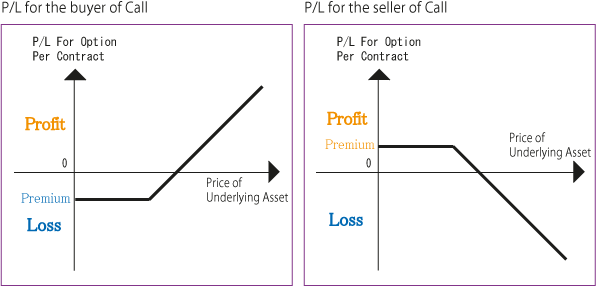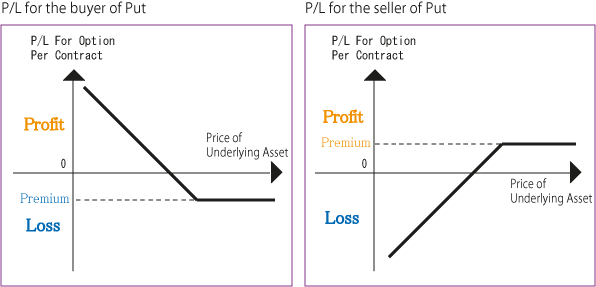5. Summary of Basics

(1). Basics and Call & Put

Now let's recap what we have learned so far.
Two basic types of options
| Call Option | The right to buy a thing (an underlying asset) |
|---|---|
| Put Option | The right to sell a thing (an underlying asset) |
Basic elements of options
| Strike Price | The price for which the option gives you the right to buy (or sell) |
|---|---|
| Premium | The price of the option itself |
| Expiration Date | On (or before) this date, the option can be exercised |
Exercise of options
| Buyers of Options | The buyer has the right to buy (or sell) underlying assets for the strike price. |
|---|---|
| Sellers of Options | The seller has the obligation to buy (or sell) underlying assets when the options they have sold are exercised. |
(2). The P/L graphs of call options on the expiration day
(3). The P/L graphs of put options on the expiration day
(4). The table of underlying asset prices and option P/L
|
Underlying Asset |
Underlying Asset |
Sideways |
Underlying Asset |
Underlying Asset |
Buy Call |
Loss |
Loss |
Loss |
Loss or Profit |
Big Profit |
Sell Call |
Profit |
Profit |
Profit |
Profit or Loss |
Big Loss |
Buy Put |
Big Profit |
Profit or Loss |
Loss |
Loss |
Loss |
Sell Put |
Big Loss |
Loss or Profit |
Profit |
Profit |
Profit |

Will I fail a class or something if I don't memorize all of these??

No, you won't fail anything. But it's important to understand what influence it will have on your positions when the price of underlying assets rise or fall.

Well, maybe I should keep it in mind.

Let me emphasize that those 4 kinds of trades in the above table are completely different in terms of risk/reward.
For example, you may consider buying calls or selling puts when the price of the underlying asset is likely to rise. But the chance of winning, the price range of the underlying asset for winning, and the maximum profit/loss are completely different in those two trades.
So check the P/L charts above when you are confused in such differences.
For example, you may consider buying calls or selling puts when the price of the underlying asset is likely to rise. But the chance of winning, the price range of the underlying asset for winning, and the maximum profit/loss are completely different in those two trades.
So check the P/L charts above when you are confused in such differences.

OK I will. But let me ask you one question now. How can traders choose the kind of trade (Call or Put/ Buy or Sell) when trading options?

We will learn how to find an edge such as "Volatility" when trading options in later lessons, so stick around!

I look forward to it.
- 1. Advantages of Options
- 2. Basics of Options
- 3. Call Option
- 4. Put Option
- 5. Summary of Basics
- 6. Intrinsic Value and Time Value
- 7. Cover Call
- 8. What is Volatility?
- 9. How to take advantage of volatility



